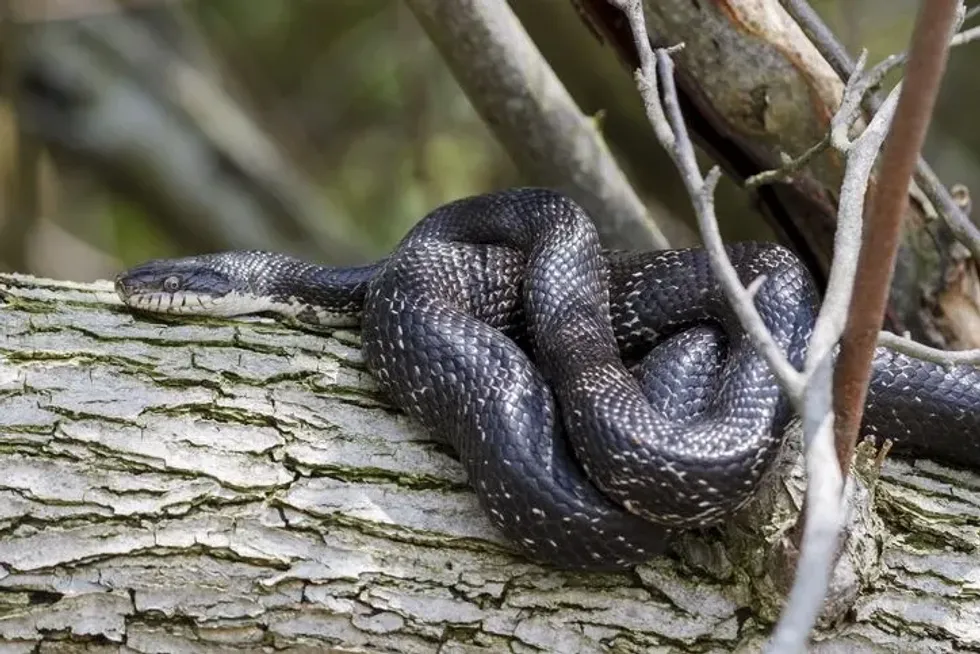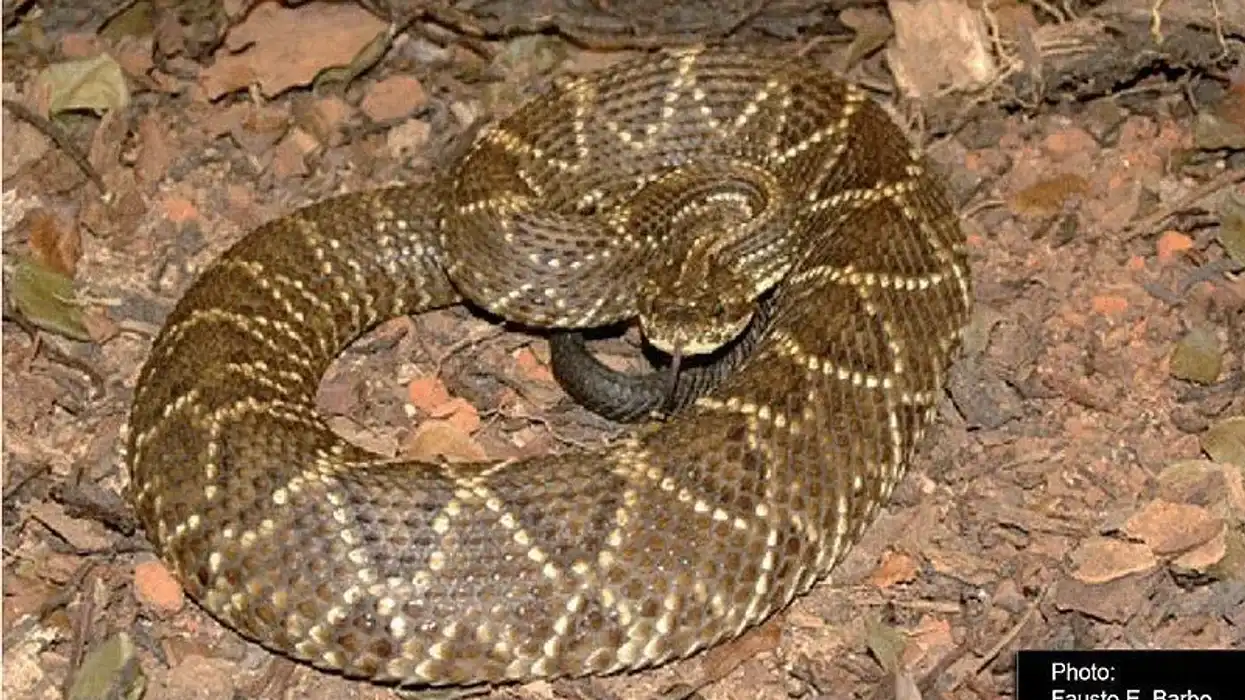Are you interested in knowing about one of the most interesting snakes that are endemic to Northern America? You have arrived at the right place to learn more about the black rat snake.
The top part of this snake is covered in black scales, whereas the bottom half has white or yellowish scales. They are distinguishable by the white chin, which makes them attractive.
Because of their similar look to the eastern rat snake, they were placed in the genus 'Elaphe,' but now, they have been placed in separate species. The black rat snake is known for its diverse habitats, and they even hibernate with other snake species.
The females lay 12-30 eggs during the mating season. Their young look distinctly different and have gray splotches on the body.
When feeling threatened, the adults of this species of rat snake can mimic the tail rattling of a venomous snake to keep predators away. These rat snakes are excellent at climbing trees, and their black color helps them to mix with the tree barks.
Aren't they interesting? Keep on reading to learn more about the snake.
Also, check out the articles on the green anaconda and the king cobra.
Black Rat Snake Interesting Facts
What type of animal is a Black Rat Snake?
A black rat snake is a type of non-venomous snake found mainly in the central part of North America. They are also known as the western rat snakes or the pilot snake.
What class of animal does a Black Rat Snake belong to?
The black rat snakes belong to the class 'Reptilia', the order 'Squamata' and fall in the suborder 'Serpentes.'
How many Black Rat Snakes are there in the world?
No conclusive data is found about the exact number of black rat snakes that are found in the wild or even for those that live in captivity.
Where does a Black Rat Snake live?
The black rat snakes prefer to live in wooded areas in different parts of North America and they are known for their wide variety of habitats. Some of the US states where the western black rat snake is seen include Mississippi, Iowa, Arkansas, Missouri, Louisiana, Texas, Kansas, and Nebraska.
What is a Black Rat Snake's habitat?
Black rat snake habitats include wooded areas, but they can make a home in several different habitats and have good adaptability. These snakes are great climbers and they are often seen on big trees. Some of their variety of habitats include forested areas, mountainous areas, and even flat farmlands.
Who do Black Rat Snakes live with?
Not much is known about the living pattern of black rat snakes. However, these snake species do hibernate during the winter oftentimes in cozy dens. During hibernation, they often live with other snakes like timber rattlesnakes, bull snakes, and racer snakes. They can also adapt to living with humans as pets.
How long does a Black Rat Snake live?
The average lifespan of black rat snakes spans around 10-15 years in the wild. However, some have even managed to live till 30 years while kept in captivity. A young black rat snake has to stay away from the several predators in its habitat that are a threat to its life.
How do they reproduce?
The mating time for black rat snakes lasts from late May to early June. The male black snakes have a hemipenis while the female rat snake possesses a cloaca, and they almost touch the organs to reproduce.
The mating can even last for hours, and as good climbers, the black rat snakes males and female adults may even mate on trees.
It takes about five weeks after the mating for the female to produce black rat snake eggs.
The average clutch size of eggs is about 12-30 eggs which hatch in about 65-70 days during the months of August-October. The black rat snake length of the young ones hatched from eggs is around 11 in – 16 in (28 cm – 41 cm), and they look quite similar to fox snakes because of the gray color.
What is their conservation status?
According to the International Union for Conservation of Nature, the black rat snakes are of 'Least Concern' and the species is still widely found in central North America.
Black Rat Snake Fun Facts
What do Black Rat Snakes look like?

By the very name 'black rat snake,' it can be understood that the scales of this snake are black in color. Once they were known as the Elaphe obsoleta, but since then, their taxonomy has been changed to Pantherophis obsoletus.
The throat, chin, and belly of this species are of a creamy yellow color that leans towards being white.
There is a morphed version of these snakes that have mostly white scales giving them the name 'white-sided black rat snake.' The mixed color of their bellies is also described as having a mottled appearance.
The juvenile black rat snake looks starkly different from their adult forms. They have silvery or light-gray blotches on their body which make them look like a mini version of fox snakes.
The young snakes also tend to have white eyes, which turn towards black as they become adults.
There is also the Texas rat snake which has dark brown-black scales, but they have been integrated under the same species. The scales of adult black rat snakes are weakly keeled, and they have a divided anal plate.
How cute are they?
Well, some may think that snakes can't be classified as 'cute' because of the notion of them being dangerous. However, the black rat snake is really cute, or classy to be exact because of its white and black appearance.
How do they communicate?
We are yet to know a lot about the communication habits between snakes. But, we do know that black rat snakes are able to produce a foul-smelling musk when they are threatened. It helps to ward off their predators or enemies.
These snakes are also able to rattle their tail to behave like venomous snakes in situations where predators are around. They even kink up their body and lay stiff, or they may coil up to prevent from becoming prey. However, in most cases, they are docile species.
How big is a Black Rat Snake?
The average length of a black rat snake is 3 feet 6 in – 6 feet (106.5cm – 183 cm). If we consider black rat snake vs black racer snake length, then the latter will have a smaller length of 3 feet - 5 feet (90 cm - 152 cm).
The black rat snake size has given them the reputation of being the largest snakes found in Canada.
How fast can a Black Rat Snake move?
The average speed of a black rat snake isn't known widely. However, the average speed of snakes is about 8 mph or 13 kph. They do move much more quickly when they sense predators.
How much does a Black Rat Snake weigh?
The average weight of black rat snakes is around 1.1 lb - 4.9 lb (0.5 kg - 2.2 kg). They can attain more weight if they have a longer body length.
What are their male and female names of the species?
There are no separate names given to a male or a female black rat snake.
What would you call a baby Black Rat Snake?
A gray-black colored baby black rat snake can be called a 'snakelet' or a 'hatchling.'
What do they eat?
By the very name 'black rat snake,' you can understand that this species preys on mice rats. It includes mice, rats, other small rodents, small mammals, birds, frogs, lizards, bird eggs, and other things.
This species of rat snakes are constrictors, so they coil around their prey to suffocate them before gulping them down.
One of the birds that they love to eat is the purple martins. The black rat snake diet isn't that complicated, which makes it a good pet for those who want to keep a black rat snake pet.
Are they poisonous?
No, they are non-venomous constrictors.
Would they make a good pet?
Yes, they do make good pets. In fact, many people are keeping the black rat snakes as their pets because of their calm and non-aggressive behavior. Another plus point is the black rat snake is non-venomous. One good thing is the low maintenance and easy black rat snake care, which makes them a good candidate for making them pets.
Did you know...
The black rat snake or Pantherophis obsoletus is often confused with the eastern black rat snake or the Pantherophis alleghaniensis. They used to be clubbed under the same binomial name, 'Elaphe obsoleta,' but it has since been changed.
The eastern rat snake is also endemic to North America. They were given a common name that has given rise to the problem.
Both also share the iconic white chin and the quality of being a pilot snake. But, they do also have a yellow variant which is missing in the black rat snakes.
Do black rat snakes have teeth?
Yes, Black Rat Snakes do have teeth. One of their ways to kill an animal is through the black rat snake bite after constricting them. It is a common misconception that snakes lack teeth. But, that is not true in most cases, though in some snake species the teeth are rudimentary.
Do black snakes keep other snakes away?
It is a common misconception that has given rise to their name 'pilot snakes.' These snakes may hibernate in the same den as venomous species like the timber rattlesnake or copperhead snakes, but they do not pilot them into the den.
So, the black rat snakes wouldn't keep other snakes away. However, some farm owners prefer the black rat snakes to be around as they hunt away rodents like other pesky pests.
Here at Kidadl, we have carefully created lots of interesting family-friendly animal facts for everyone to discover! Learn more about some other reptiles including the Burmese python and the rattlesnake.
You can even occupy yourself at home by drawing one on our Black rat snake coloring pages.










